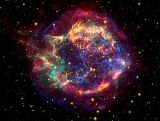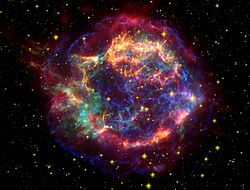
Cassiopeia A
Encyclopedia


Supernova remnant
A supernova remnant is the structure resulting from the explosion of a star in a supernova. The supernova remnant is bounded by an expanding shock wave, and consists of ejected material expanding from the explosion, and the interstellar material it sweeps up and shocks along the way.There are two...
in the constellation Cassiopeia
Cassiopeia (constellation)
Cassiopeia is a constellation in the northern sky, named after the vain queen Cassiopeia in Greek mythology, who boasted about her unrivalled beauty. Cassiopea was one of the 48 constellations listed by the 2nd century Greek astronomer Ptolemy, and it remains one of the 88 modern constellations today...
and the brightest astronomical radio source in the sky, with a flux density of 2720 Jy
Jansky
The flux unit or jansky is a non-SI unit of spectral flux density equivalent to 10−26 watts per square metre per hertz...
at 1 GHz
Hertz
The hertz is the SI unit of frequency defined as the number of cycles per second of a periodic phenomenon. One of its most common uses is the description of the sine wave, particularly those used in radio and audio applications....
. The supernova occurred approximately 11000 ly away in the Milky Way
Milky Way
The Milky Way is the galaxy that contains the Solar System. This name derives from its appearance as a dim un-resolved "milky" glowing band arching across the night sky...
. The expanding cloud of material left over from the supernova
Supernova
A supernova is a stellar explosion that is more energetic than a nova. It is pronounced with the plural supernovae or supernovas. Supernovae are extremely luminous and cause a burst of radiation that often briefly outshines an entire galaxy, before fading from view over several weeks or months...
is now approximately 10 ly across. Despite its radio brilliance, however, it is extremely faint optically, and is only visible on long-exposure photographs.
It is believed that first light from the stellar explosion reached Earth approximately 300 years ago but there are no historical records of any sightings of the progenitor supernova, probably due to interstellar dust absorbing optical wavelength radiation before it reached Earth (although it is possible that it was recorded as a sixth magnitude star 3 Cassiopeiae
3 Cassiopeiae
3 Cassiopeiae is a hypothetical star catalogued by English astronomer John Flamsteed. It bears no identity with actual stars observed today. Unlike 34 Tauri, which was the planet Uranus, 3 Cas was not reconciled by later knowledge....
by John Flamsteed
John Flamsteed
Sir John Flamsteed FRS was an English astronomer and the first Astronomer Royal. He catalogued over 3000 stars.- Life :Flamsteed was born in Denby, Derbyshire, England, the only son of Stephen Flamsteed...
on August 16, 1680). Possible explanations lean toward the idea that the source star was unusually massive and had previously ejected much of its outer layers. These outer layers would have cloaked the star and reabsorbed much of the light released as the inner star collapsed.
Cas A is 3C461 in the Third Cambridge Catalogue of Radio Sources
Third Cambridge Catalogue of Radio Sources
The Third Cambridge Catalogue of Radio Sources is an astronomical catalogue of celestial radio sources detected originally at 159 MHz, and subsequently at 178 MHz. It was published in 1959 by members of the Radio Astronomy Group of the University of Cambridge...
and G111.7-2.1 in the Green Catalog of Supernova Remnants.
The expansion shell has a temperature of around 50 million degrees Fahrenheit
Fahrenheit
Fahrenheit is the temperature scale proposed in 1724 by, and named after, the German physicist Daniel Gabriel Fahrenheit . Within this scale, the freezing of water into ice is defined at 32 degrees, while the boiling point of water is defined to be 212 degrees...
(30 megakelvins), and is expanding at 4000−6000 km/s.
Cas A is the strongest radio source in the sky beyond our solar system
Solar System
The Solar System consists of the Sun and the astronomical objects gravitationally bound in orbit around it, all of which formed from the collapse of a giant molecular cloud approximately 4.6 billion years ago. The vast majority of the system's mass is in the Sun...
, and was among the first discrete sources to be found, in 1947. The optical component was first identified in 1950.
X-ray source
In 1979, Shklovsky predicted that Cas A had a black holeBlack hole
A black hole is a region of spacetime from which nothing, not even light, can escape. The theory of general relativity predicts that a sufficiently compact mass will deform spacetime to form a black hole. Around a black hole there is a mathematically defined surface called an event horizon that...
. In 1999, the Chandra X-Ray Observatory
Chandra X-ray Observatory
The Chandra X-ray Observatory is a satellite launched on STS-93 by NASA on July 23, 1999. It was named in honor of Indian-American physicist Subrahmanyan Chandrasekhar who is known for determining the maximum mass for white dwarfs. "Chandra" also means "moon" or "luminous" in Sanskrit.Chandra...
found a "hot point-like source" close to the center of the nebula that is quite likely the neutron star
Neutron star
A neutron star is a type of stellar remnant that can result from the gravitational collapse of a massive star during a Type II, Type Ib or Type Ic supernova event. Such stars are composed almost entirely of neutrons, which are subatomic particles without electrical charge and with a slightly larger...
or black hole predicted but not previously found.
Although Cas X-1 (or Cas XR-1), the apparent first X-ray source in the constellation
Constellation
In modern astronomy, a constellation is an internationally defined area of the celestial sphere. These areas are grouped around asterisms, patterns formed by prominent stars within apparent proximity to one another on Earth's night sky....
Cassiopeia
Cassiopeia (constellation)
Cassiopeia is a constellation in the northern sky, named after the vain queen Cassiopeia in Greek mythology, who boasted about her unrivalled beauty. Cassiopea was one of the 48 constellations listed by the 2nd century Greek astronomer Ptolemy, and it remains one of the 88 modern constellations today...
was not detected during the June 16, 1964, Aerobee sounding rocket
Sounding rocket
A sounding rocket, sometimes called a research rocket, is an instrument-carrying rocket designed to take measurements and perform scientific experiments during its sub-orbital flight. The origin of the term comes from nautical vocabulary, where to sound is to throw a weighted line from a ship into...
flight, it was considered as a possible source. Cas A was scanned during another Aerobee rocket flight of October 1, 1964, but no significant X-ray flux above background was associated with the position. Cas XR-1 was discovered by an Aerobee rocket flight on April 25, 1965, at RA
Right ascension
Right ascension is the astronomical term for one of the two coordinates of a point on the celestial sphere when using the equatorial coordinate system. The other coordinate is the declination.-Explanation:...
Dec
Declination
In astronomy, declination is one of the two coordinates of the equatorial coordinate system, the other being either right ascension or hour angle. Declination in astronomy is comparable to geographic latitude, but projected onto the celestial sphere. Declination is measured in degrees north and...
. Cas X-1 is Cas A, a Type II SNR at RA
Right ascension
Right ascension is the astronomical term for one of the two coordinates of a point on the celestial sphere when using the equatorial coordinate system. The other coordinate is the declination.-Explanation:...
Dec
Declination
In astronomy, declination is one of the two coordinates of the equatorial coordinate system, the other being either right ascension or hour angle. Declination in astronomy is comparable to geographic latitude, but projected onto the celestial sphere. Declination is measured in degrees north and...
.
The designations Cassiopeia X-1, Cas XR-1, Cas X-1 are no longer used, but the X-ray source is Cas A (SNR
Supernova remnant
A supernova remnant is the structure resulting from the explosion of a star in a supernova. The supernova remnant is bounded by an expanding shock wave, and consists of ejected material expanding from the explosion, and the interstellar material it sweeps up and shocks along the way.There are two...
G111.7-02.1) at 2U 2321+58.
Expansion
Calculations working back from the currently observed expansion point to an explosion that would have become visible on Earth around 1667. Astronomer William Ashworth and others have suggested that the Astronomer RoyalAstronomer Royal
Astronomer Royal is a senior post in the Royal Household of the Sovereign of the United Kingdom. There are two officers, the senior being the Astronomer Royal dating from 22 June 1675; the second is the Astronomer Royal for Scotland dating from 1834....
John Flamsteed
John Flamsteed
Sir John Flamsteed FRS was an English astronomer and the first Astronomer Royal. He catalogued over 3000 stars.- Life :Flamsteed was born in Denby, Derbyshire, England, the only son of Stephen Flamsteed...
may have inadvertently observed the supernova on August 16, 1680, when he catalogued a star near its position. Another suggestion from recent cross-disciplinary research is that the supernova was the mythical "noon day star", observed in 1630, that heralded the birth of Charles II
Charles II of England
Charles II was monarch of the three kingdoms of England, Scotland, and Ireland.Charles II's father, King Charles I, was executed at Whitehall on 30 January 1649, at the climax of the English Civil War...
, the future monarch of Great Britain. At any rate, no supernova in the Milky Way
Milky Way
The Milky Way is the galaxy that contains the Solar System. This name derives from its appearance as a dim un-resolved "milky" glowing band arching across the night sky...
has been visible to the naked eye from Earth since. Observations of the exploded star through the Hubble telescope have shown that, despite the original belief that the remnants were expanding in a uniform manner, there are high velocity outlying eject knots moving with transverse velocities of 5,500−14,500 km/s with the highest speeds occurring in two nearly opposing jets. When the view of the expanding star uses colors to differentiate materials of different chemical compositions, it shows that similar materials often remain gathered together in the remnants of the explosion.
Observation of supernova reflected echo
Recently, infrared echo of Cassiopeia A explosion was observed on nearby gas clouds using Spitzer Space TelescopeSpitzer Space Telescope
The Spitzer Space Telescope , formerly the Space Infrared Telescope Facility is an infrared space observatory launched in 2003...
. The recorded spectrum proved the supernova was of Type IIb, meaning it resulted from the internal collapse and violent explosion of a massive star
Star
A star is a massive, luminous sphere of plasma held together by gravity. At the end of its lifetime, a star can also contain a proportion of degenerate matter. The nearest star to Earth is the Sun, which is the source of most of the energy on Earth...
, most probably a red supergiant
Red supergiant
Red supergiants are supergiant stars of spectral type K or M. They are the largest stars in the universe in terms of volume, although they are not the most massive...
with a helium core which had lost almost all of its hydrogen envelope. This was the first observation of the infrared echo of a supernova which explosion had not been directly observed which opens up the possibility of studying and reconstructing past astronomical events.
External links
- 3D visualisation of Cassiopeia A, BBC NewsBBC NewsBBC News is the department of the British Broadcasting Corporation responsible for the gathering and broadcasting of news and current affairs. The department is the world's largest broadcast news organisation and generates about 120 hours of radio and television output each day, as well as online...
.

